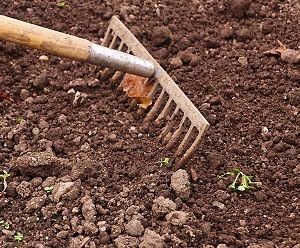Soil Care
At Burkholder Plant Health Care, our approach to soil care is to provide top of the industry service, tailored to the client’s exact needs. Soils are arguably the most important, yet undervalued aspect of plant health care. Soil supplies water, nutrients, oxygen, and a physical foundation for proper root and stem growth. At Burkholder Plant Health Care, Inc. we understand these issues and offer a full range of soil services to meet both the needs of the plants and the priorities of the customer.

Soil Nutrition Analysis
Our plant health care program includes soil sampling and testing to pinpoint the exact needs of your trees and landscape plants. Our trained technicians monitor soil conditions by sampling and testing your soil throughout the year. Soil sample results identify nutrient deficiencies, pH imbalance, and organic matter content from which a prescription soil plan can be derived. Soil amendments and fertilization can pose many risks if done improperly and should only be conducted by trained plant health care professionals to ensure proper plant targets, rates, and application methods. We apply our specialty fertilizers through soil injection, soil drench, and granular applications, as called for by the nutrient complex being applied and the details of the plants to be treated.
Spring Soil Amendment
In the spring, we offer and recommend a potassium-only fertilizer (0-0-30) to supply plants with the necessary nutrients to improve resistance to stress factors such as disease pressure, extreme temperature fluctuations, and drought conditions. This systemic nutrient formulation is readily available to the plant after application and stimulates health and vigor without triggering excess physical growth.
Fall Soil Amendment
Fertilizing with a slow-release N-P-K (16-4-5) fertilizer in the fall ensures the availability of essential macro and micronutrients. During this time, plants are absorbing and storing nutrients for the initial spring growth period, making it imperative to supply the nutrients often lacking in landscape soils. This will supply your plants and trees with nutrients throughout the year and provide the sustenance needed to promote healthy growth, fight insect and disease infestations, and endure harsh environmental conditions.
Prescription Soil Treatment
In a landscape setting, inadequate soil conditions contribute more to poor plant performance than any other factor. Nutrient availability of the soil is largely dependent on the “soil reaction” (pH), and at specific pH levels, some nutrients become unavailable for absorption, which can be fatal to your plants. Whether the problems in plant health are associated with micro or macronutrient deficiency, pH, or soil structure, we have the tools to tailor soil amendment and conditioning to the site-specific needs of your landscape.
Soil Restoration
Soils in landscape settings are often disturbed from their typical makeup. The top layer, being mostly organic, is often stripped away at the time of construction and replaced with sediment and waste soil that lacks the structure and components of a healthy, developed soil. The structure of the soil is further compacted by heavy machinery, reducing the amount of pore space crucial for holding water and oxygen. Soils are living, dynamic systems involving many inputs and outputs that are constantly interacting. For example, rainwater contributes to the acidification of soil due to its slightly acidic nature. Annual leaf cleanups remove most nutrients from your landscape. In natural settings, microbes and worms break down this plant material and return it to the soil in the form of nitrogen, phosphorus, potassium, and calcium. In landscape areas that plants simply will not thrive, it is not uncommon to need a full restoration of the soil foundation, including nutrient amendment, pH balance, addition of organic matter, improvement of drainage, and conditioning of soil structure.
Symptoms of common nutrient deficiencies in soils supporting landscape beds, foundation beds, and feature trees:
| Nutrient | Role | Symptoms |
|---|---|---|
Nitrogen | Essential role in production of proteins and chlorophyll. | Chlorosis, poor growth, yellowing leaves (generally at the bottom of the plant first). |
Phosphorous | Crucial in photosynthetic processes, may reduce drought stress. | Stunting, purpling, or bronzing of leaves, particularly the undersides of older leaves. |
Potassium | May improve resistance to stress and disease, aids in photosynthetic and respiratory processes. | Marginal chlorosis on younger leaves (yellowing or browning of the leaf edges), and eventual scorch (browning) from the outside edges of leaves toward the center line. |
Sulfur | Vital role in amino acids that form proteins, acidifies soil, making other nutrients more available. | Yellowing or pale foliage, stunted growth, veinal chlorosis (lighter-colored leaf veins than surrounding tissue), spindly and stunted growth. |
Calcium | Vital in cellular division and respiration. | New leaves, buds, and roots have stunted growth, young leaves are pale, curl downward, and browning from the tips toward the petiole (stem). |
Magnesium | Aids in protein synthesis and respiration. | Pale leaves, and interveinal chlorosis (yellowing between the leaf veins, with the veins remaining green), smaller mature leaves and leaf drop. |
Iron | Vital in transporting oxygen. | Similar to magnesium deficiency, but on newly formed leaves. Yellowing of young leaves and shoots, interveinal chlorosis, and tissue death. |
Manganese | Aids in protein synthesis and enzyme systems. | Yellowing between the leaf veins, with wide bands of green remaining on the veins themselves. Dead spots on leaves, followed by tip dieback. |
Zinc | Activates the plant’s own growth regulators. | Yellowing and mottling of young leaves, small leaves with browning patches and curling/wrinkling. |
Boron | Essential in cell division and differentiation in growth of tips. | Cupping or wrinkling of new leaves, development of dense lateral branching (witches’ broom), stunting and deformation of rapidly growing tips. |


